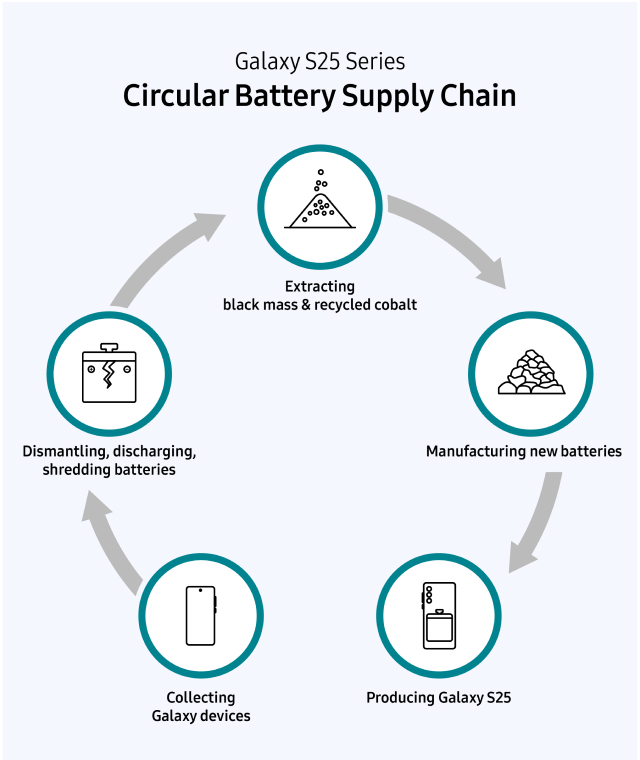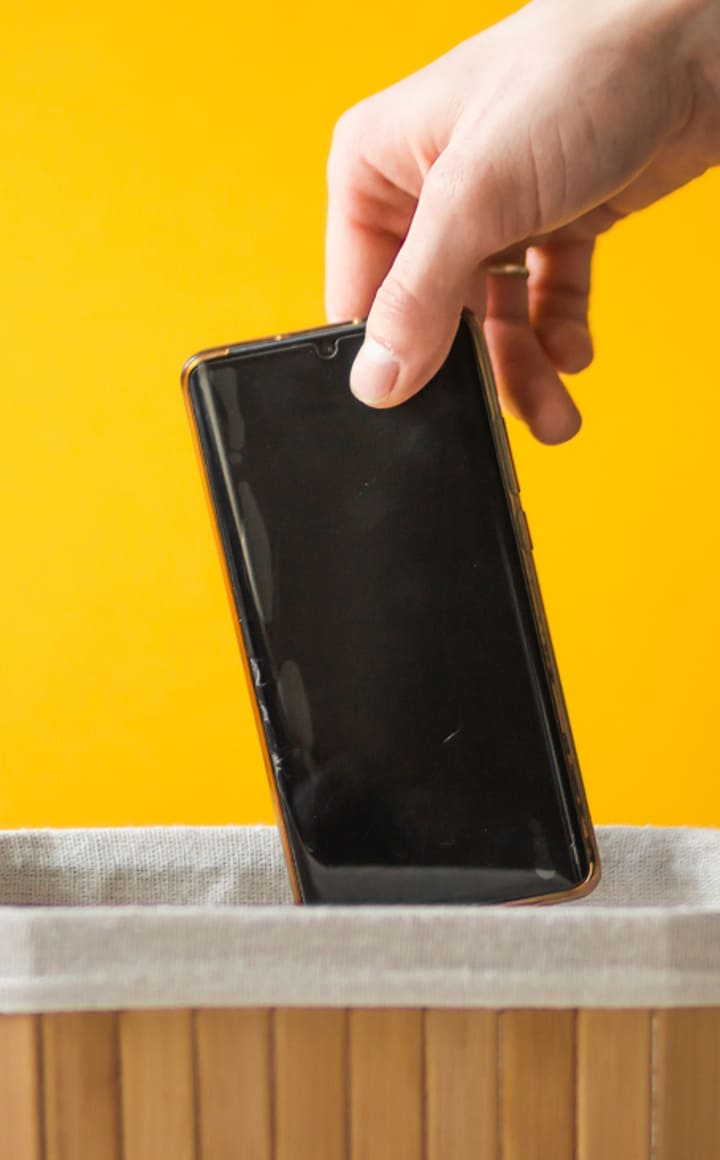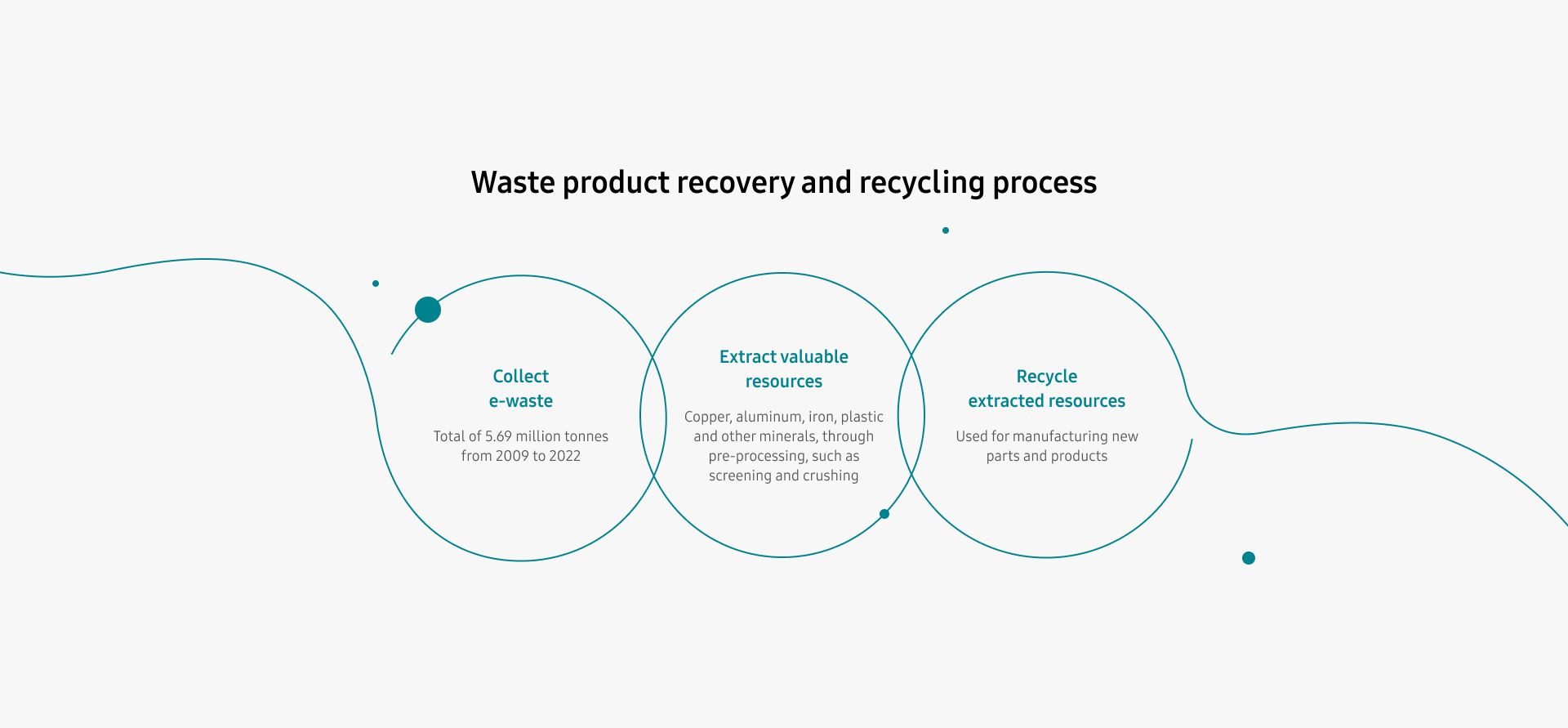Using Recycled
Materials
E-waste, born again with
technology
Recycled materials roadmap
2023 - Ocean-bound plastic recycled and applied to DX products, Circular Economy Lab established / 2024 - 768,811 tonnes of plastic containing recycled materials used cumulatively since 2009 / 2030 - Aim to apply recycled plastic¹) to 50%²) of plastic parts³) in DX products, establish a recycling system for minerals recovered from collected waste batteries / 2050 - Aim to apply recycled plastic¹) to 100%²) of plastic parts³) in DX products
- Ratio of recycled content varies by plastic parts
- Percentage of parts containing recycled materials out of the total amount of parts
- Plastic parts developed by Samsung
- Ocean-bound plastic recycled and applied to DX products
- Circular Economy Lab established
- 567,056 tonnes of plastic with recycled resin used cumulatively since 2009
- Aim to apply recycled plastic1) to 50%2) of plastic parts3) in DX products
- Establish a recycling system for minerals recovered from collected waste batteries
- Aim to apply recycled plastic1) to 100%2) of plastic parts3) in DX products

Our products give
a
new life to materials

We strive to use recycled materials
in our products.
We are constantly looking for ways to minimize our impact on the land and sea. By focusing on plastic waste as one of the biggest threats to the marine environment, we have developed technology to recycle discarded fishing nets and are continuing our efforts to improve circularity by recycling resources.
Along with the recycled plastic1), rare earth elements2), steel3), and glass4), the Samsung Galaxy S25 Series released in 2025 incorporates new recycled materials such as recycled gold5), copper6), cobalt7), and aluminum8). The Galaxy S25 and S25+ frames also incorporate recycled Armor Aluminum.
In addition, the Galaxy S25 uses recycled cobalt extracted from previously used Galaxy smartphones and batteries discarded during the manufacturing process through Circular Battery Supply Chain. Furthermore, recycled plastics from wafer trays discarded during the semiconductor manufacturing process have been newly applied.
Our efforts to scale the use of recycled materials extend to televisions as well. The graphite sheets of the 2024 and 2025 Neo QLED 8K televisions, used for internal heat dissipation, contain recycled graphite9) extracted from end-of-life batteries.
- Galaxy S25 Series incorporates recycled plastic in various components, such as 80% in the Back Glass Deco Film, 30% in the Volume Key and Side Key, 20% in the Top & Bottom Speaker Module (Upper and Lower) and 10% in the Front Case.
- The magnets used in the Speaker Modules and Motor are made from 100% recycled rare earth elements (neodymium).
- Some steel components in the Speaker Modules contain at least 40% recycled steel (Including 40% in the Galaxy S25 Ultra Top Speaker Module Grill and 70% in the Galaxy S25 Series' Bottom Speaker Module Lower).
- The S25 and S25+ feature recycled glass on both the front and back, while the S25 Ultra includes recycled glass on the back.
- The bonding wires in the Front and 3x Telephoto Camera Modules of the S25 Ultra, as well as the gold plating on the main Printed Circuit Boards (PCBs) of the S25 and S25+, are made from 100% recycled gold.
- The copper foil used in various modules such as Display, Camera, and Wireless Charging Module, and main Printed Circuit Boards (PCBs) is made 100% of recycled copper.
- A minimum of 25% of the batteries of the Galaxy S25 is cobalt by weight, 50% of which is recycled cobalt.
- In the S25 Ultra, the Volume Key and Side Key contain 28% recycled aluminum, while the Internal Front Case Inserts and Rear Camera Deco contain 30% recycled aluminum. In the S25 and S25+, the Armor Aluminum used in the Front Case contains 20% recycled material.
- Of the six graphite sheets used inside the 2024 models, five contain recycled materials. This does not apply to certain 2025 models that do not include the One Connect Box.
plastic parts
We are significantly expanding the application of recycled materials in plastic parts used in products — 50% of plastic parts by 2030 and 100% plastic parts (by weight) by 2050.
In 2024, we used 201,755 tonnes of plastics with recycled materials, about 1.3 times more than in 2023.
- Unit: 10,000 tonnes
- Usage for the current year
- Total cumulative usage
Double bar chart showing figures from 2022 to 2024. 2022: 9.9, 40.9 / 2023: 15.8, 56.7 / 2024: 20.2, 76.9.


How did abandoned
fishing
nets become a part of Galaxy?
Learn more
-
Expanding the scope of
recycled material useLearn more -
Our efforts to recycle
by-products from
semiconductor
manufacturingLearn more
From recycled, for recycling
The use of recycled packaging
materials by product category
Extending
Product Life
Get more out of our products


The longer the product
lifespan, the less
resources consumed
We continue to increase the lifespan of our products because longer lifecycles often mean fewer resources consumed and less carbon emitted.
To reduce the environmental impact of our products, we study and apply ways for our customers to use our products longer.
Collecting and
Recycling E-waste
Bringing new life
to EOL(End Of Life) products
E-waste collection and
recycling roadmap
- * Cumulative from 2009
*Cumulative from 2009


Not just thrown away
but repurposed
When we switch to a new product, where does the used product end up?
If you think about it, products made from various raw materials are a complex mix of resources. Our e-waste product collection and recycling process allow for e-waste to become ingredients for new products.
From 2009 to 2024, we collected 6.9 million tonnes of waste electronics worldwide through e-waste collection system operated in over 80 countries.
By 2030, we plan to expand the e-waste collection system to all global regions where our products are sold, with the plan to collect a total of 10 million tonnes accumulated since 2009. Furthermore, we also plan to collect 25 million tonnes of e-waste by 2050.
- Unit: 10,000 tonnes
- Collected amount (current year)
- Cumulative collected amount
Double bar chart showing figures from 2022 to 2024. 2022: 59.9, 569.8 / 2023: 59.9, 629.7 / 2024: 61.1, 690.9



Click a region to see a detailed list
of country/region.
E- Waste recovery and recycling programs
-
Korea
E-waste recovery and
recycling program in Korea Learn more -
U.S.
E-waste recovery and
recycling program in the U.S. Learn more -
EU, Asia, and Africa
E- Waste recovery and recycling
programs in EU, Asia, and Africa Learn more

















































